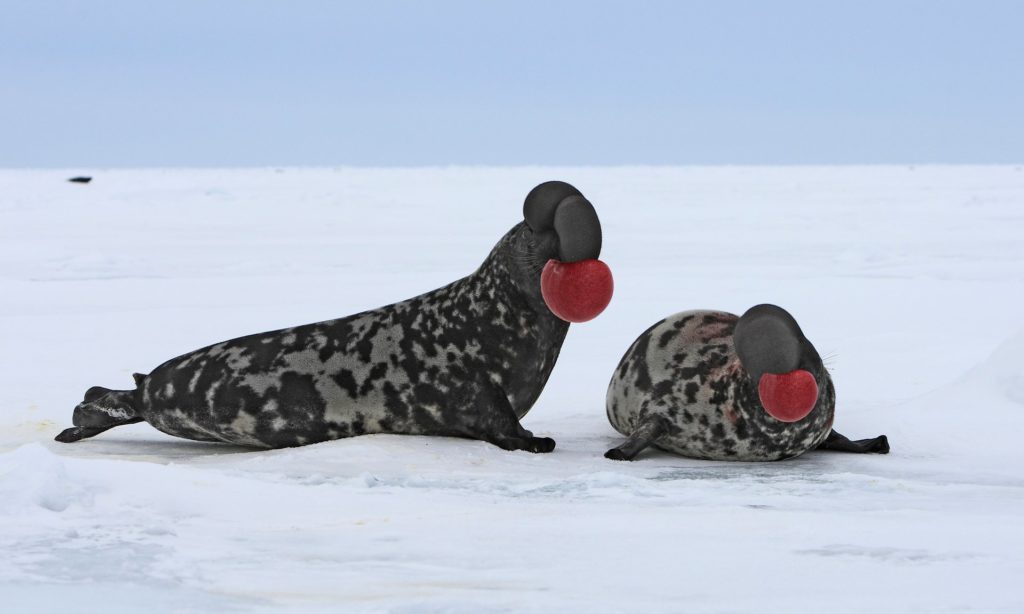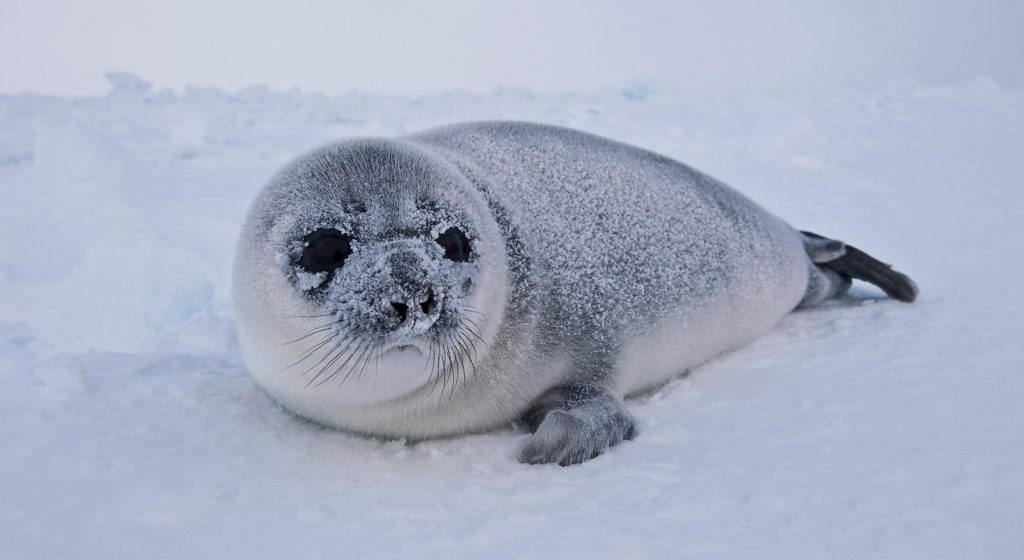We invite you to meet the hooded seals, Capuchin seals, or Cystophora cristata in scientific terms, which are pelagic creatures that inhabit mainly north of the Atlantic and also in the Arctic Ocean of whom really worth to learn about.
Table Of Content
Hooded Seals: Main Characteristics
These seals have a black face and greyish blue fur with dark stain patterns; although when they are underwater their bodies show an uniform color. However, the main reason of their name relies on the surprising nasal appendage that adorns the head of adult males which develop around 4 years of age. 
The males´wide, fleshy snout leans over their mouth, but when inflated, it forms a striking “bulbous hood» on the top of the head which gives it a ball-like appearance by its oval figure. Males also have an inflatable nasal membrane that expands like a red balloon when they shake.
The hood and membrane are used by them to show aggression when they are threatened, and as a warning during the breeding season. In the case of females, they don´t have the ability to swell their snouts in the way they do in males, since they are not so developed.
Their fins have many claws and their wide hind legs are extremely efficient in the water, but useless on the ground, while the smaller ones have a main function in driving rather than propulsion.
Size and Weight:
This species, like the southern elephants Seals has sexual dimorphism, since females have smaller measures than males. As far as their bodies´ total length is concerned, the adult male measures about 260 centimeters on average, although cases of up to 350 centimeters have been reported.
For its part, the adult female hooded seals have an average length of about 200 centimeters.
Although there are considerable differences between their bodies´ lengths, it is worth mentioning that the main difference between the genera of this species is reflected in their body weights.
The male hooded seals weigh about 300 kilograms in average, while females only reach about 160 kilograms. However, the differences in size and weight of the offspring of both sexes, is only one meter long, with a difference in weight not bigger than 24 kilograms.
Let’s watch them
Hooded Seals: Reproduction and Life cycle
Female hooded seals mature between 3-6 years, while males at 5-7 years old. The amount of exchange between the different populations of this species which is highly migratory is not clear, although a short time ago was reported the sighting of a hybrid of this species with another species of seals.
Puppies are usually born between March and April with a well-developed layer of fat and a blue-gray fur, which originates their nicknames “Blueback «.
The breastfeeding only lasts an average of 3.8 days, and is the shortest lactation period of any mammal.
Despite this fact the puppy is doubled in size from approximately 24 kg to approximately 47kgms, thanks to the mother’s rich milk made up of 60-70% of fat.
When females begin to give birth, males begin to compete fighting with each other in the breeding territory, using for this purpose their characteristic nasal appendages.
Then they wait to mate while women care for their offspring forming this way temporal «families” or «triads» (male, female and calf). After the puppy is weaned, the male and female mate in the water. Several hours after mating, the male returns to the breeding territory in search of another female.
Hooded Seals: Habitat and Distribution
This is a migratory species with a range that covers a large portion of the North Atlantic. The annual movement of the hooded seals generally follows the movement of the ice blocks.
There are four main breeding areas including: Gulf of San Lorenzo; an area north of Newfoundland known as the Front; the Davis Strait; and in West Ice, east of Greenland.
Outside of the breeding season, it is not uncommon for the hooded seals to be observed outside their normal range, with juvenile specimens even reaching Portugal, Florida and even California in the Pacific.
The Hooded Seals’ Alimentation Habits
Hooded seals are fed in deep water immersed in depths of 100-600 m. Their diet varies regionally and includes: Greenland halibut, redfish, cod, mackerel and herring.
They also eat octopus, squid, shrimp and mussels. Known predators of hooded seals are polar bears, Greenland sharks, and killer whales
 Hooded Seals Main Threats
Hooded Seals Main Threats
These creatures have been hunted for hundreds of years, but their exploitation was significantly widened during the nineteenth and twentieth centuries, when their commercial hunting intensified.
Until 1930, the fat and leather were the main products derived from the hooded seals.
However, the increase of their demand following the Second World War caused that the young blue-backs´ attractive skin became in the main objective.
As their commercial hunting became increasingly untenable, numerous legislative measures were introduced to protect this species during the second half of the twentieth century.
Since the implementation of various contingents, agreements and treaties, the hooded seal population in the north-west Atlantic has stabilized, but for unknown reasons, the population of the north-East Atlantic still seems to be declining at an alarming rate.
Although commercial hunting of this species poses a small threat these days in relation to 50 years ago, there are other factors such as catches by fishing in coastal net fisheries, competition for food with commercial fisheries; and oil spills and other forms of pollution that continue to threaten them.
Moreover, being an ice blocks´ species, the effect of global warming can have a devastating effect on their ability to reproduce
All yours…




